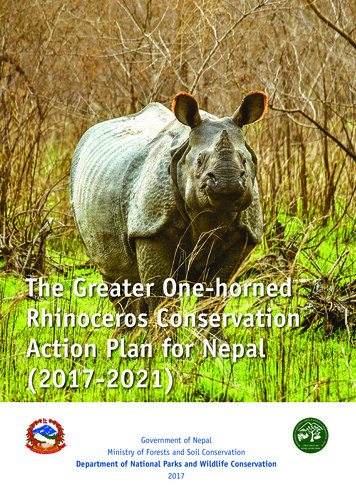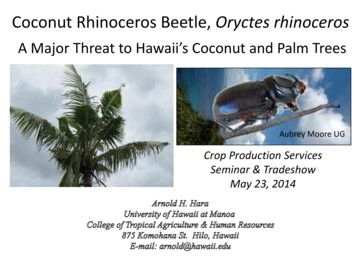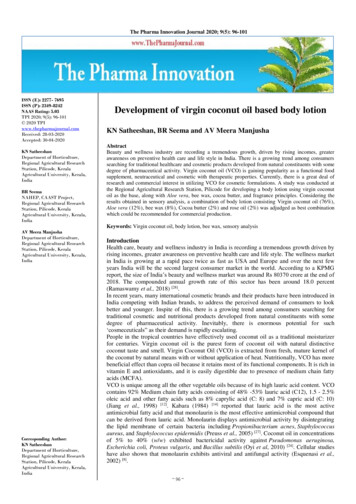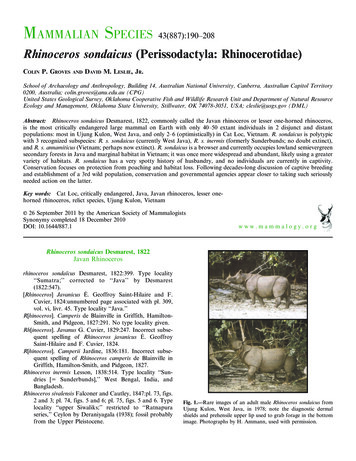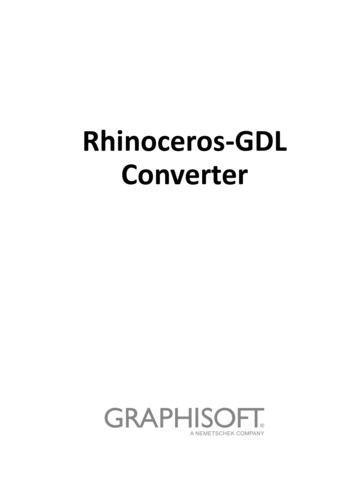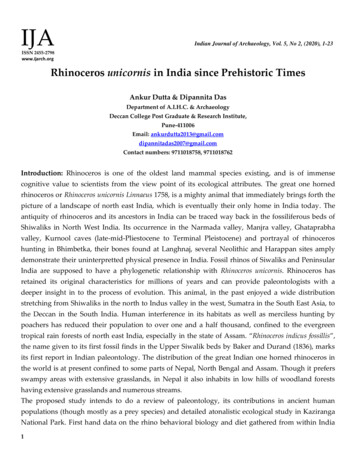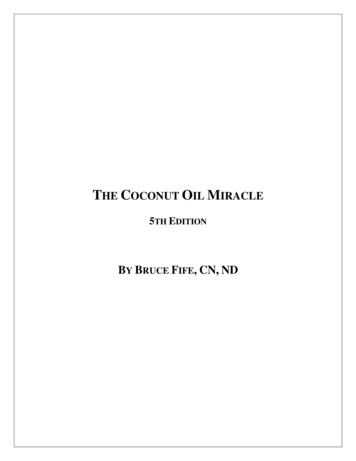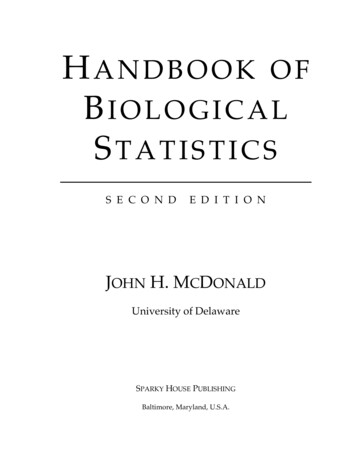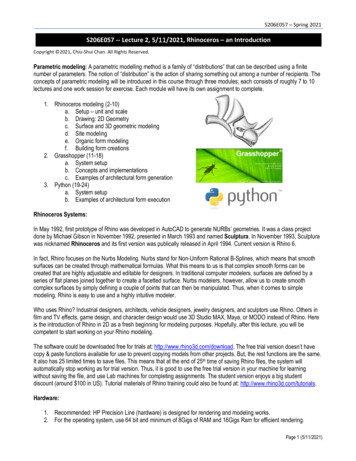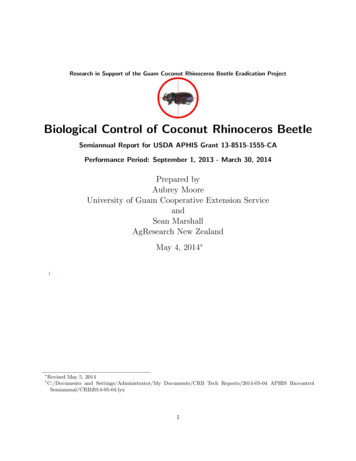
Transcription
Research in Support of the Guam Coconut Rhinoceros Beetle Eradication ProjectBiological Control of Coconut Rhinoceros BeetleSemiannual Report for USDA APHIS Grant 13-8515-1555-CAPerformance Period: September 1, 2013 - March 30, 2014Prepared byAubrey MooreUniversity of Guam Cooperative Extension ServiceandSean MarshallAgResearch New ZealandMay 4, 2014 1 1Revised May 5, 2014C:/Documents and Settings/Administrator/My Documents/CRB Tech Reports/2014-05-04 APHIS BiocontrolSemiannual/CRB2014-05-04.lyx1
1 Summary Two insect pathogens have been introduced to Guam under USDA-APHIS import permits:for biological control of the coconut rhinoceros beetle (CRB): Oryctes nudivirus (OrNV) andgreen muscardine fungus (GMF), Metarhyzium majus. The host range of both pathogens islimited to Dynastinae, the subfamily of scarab beetles containing CRB, which is the onlyrepresentative of this subfamily on Guam. Half of the current grant funds support a collaboration with Dr. Sean Marshall and Dr. Trevor Jackson of AgResearch New Zealand to workon the virus, and the remaining half is allocated for to measure the efficacy of GMF. Dr.Marshall made two trips to Guam, during January and February 2014 to perform bioassaysin the quarantine laboratory at the Guam Plant Inspection Facility. OrNV. This virus has been very effective in reducing CRB damage keeping it at low levelselsewhere in the Pacific. However, laboratory bioassays indicate that the Guam CRB maybe resistant to all strains of the virus tested to date. The primary goal of current researchis to find a strain of OrNV which is highly pathogenic for the Guam CRB beetle population, and to autodisseminated this strain. Although results obtained during this project havedemonstrated that the Guam CRB population is not resistant to OrNV infection, the possibility remains that the Guam CRB population has a degree of tolerance towards OrNV(or possibly to a subset of OrNV isolates). A genetic marker has recently been developedthat distinguishes the Guam CRB population from other CRB populations (see the Supplementary Data section). The recently identified Hawaiian CRB population shares the samegenetic marker that is present in the Guam CRB population. While the number of CRBpopulations tested for genotypes outside of Guam is still relatively small (i.e. Samoa, Fiji,PNG, Malaysia, Diego Garcia), OrNV is known to infect CRB in these other regions. Thecorrelation of the genetic difference observed in Guam compared to other CRB specimens andthe difficulties in establishing OrNV infection in the Guam population raises the possibilitythat the Guam (and Hawaiian) CRB populations are less susceptible to OrNV infection. Wenote that conclusive evidence for this hypothesis is not currently available for the Guam (orHawaiian) population and therefore requires further research. However, Zelazny et al. (1989)have previously reported tolerance towards OrNV infection and transmission within someCRB populations. GMF. For the past 3 years, we have been importing GMF spores produced by Dr. AmbrosioAlfiler of the Philippine Coconut Authority. The spores are distributed in two ways: by directapplication to CRB breeding sites and by dusting adult male CRB for autodissemination. Thefungus has established on Guam indicated that we find it in breeding sites far from any releasesites. Prior to the initial release of GMF, we found no CRB larvae or adults infected withGMF on Guam. The objective of the current grant is to measure the impact of this pathogenon the Guam CRB population. This work has been delayed because the technician taskedwith this work quit unexpectedly. A replacement has just been hired. Assistance to the Hawaii CRB Project. We obtained the first 4 beetles detected inthe current Hawaiian infestation for dissection and genotyping. All were females and twoof theses were gravid. DNA from the 4 CRB adults collected in Hawai were compared toDNA samples from other CRB populations in the Pacidic using restriction fragment lengthpolymorphism (RFLP) analysis. The Guam and Hawaii populations have DNA which breaksinto 253 bp fragments. DNA fragments 2of this size are absent in DNA samples from DiegoGarcia, Fiji, Samoa, and PNG. Thus the Hawaii population may have originated from Guamor a currently unknown common source.
2 Signature Page3
3 Results Guam Oryctes Nudivirus Bioassays5
University of Guam - USDA APHIS Funding Report“Entomopathogenic virus for biological control of coconut rhinoceros beetle on Guam”Funding support provided via USDA APHIS Grant 12-8515-1555-CASubcontract Report to University of GuamPerformance Period: July 2013 - March, 2014Prepared by: Sean Marshall (AgResearch, NZ)April 17, 2014Project Aims1. Obtain and Disseminate Virus Strains Which Kill Guam's Rhino Beetles.Oryctes nudivirus (OrNV) has been effective in reducing coconut rhinoceros beetle (CRB) populationlevels and keeping them at low levels elsewhere in the Pacific. Our objective is to obtain samples ofvirus strains which are highly pathogenic for the Guam CRB population.2. Determine Why Previously Tested Virus Strains Failed to Kill Guam's Rhino Beetles. Suppressionof CRB populations on Pacific Islands using OrNV has been very successful over the past 50 years,and has become the major tactic in the region. Several successful CRB biocontol projects using OrNVhave been run by the Secretariat of the Pacific Community (SPC). Failure of OrNV on Guam maymean that we are dealing with a virus-resistant population of beetles. It is of regional importance todetermine reasons for this in order to prevent similar failures elsewhere.Project SummaryThe initial attempts to infect CRB with OrNV were based on the food incorporation method, whichinvolved feeding CRB banana contaminated with OrNV or a control without OrNV. Treated bananawas placed into a jar containing a single beetle and the standard rearing material (i.e. dampcommercially produced garden centre sphagnum peat moss). Analysis of bioassay data showed nodemonstrable effect of the virus on gut morphology or beetle mortality and suggested that OrNVinfection did not establish. Failure to establish infection in these initial experiments was unexpected.Further investigation included testing of freshly prepared OrNV-X2B (the same isolate used in theinitial bioassay, but a different batch), the OrNV-B isolate, a mixture made up from 5 different OrNVisolates (PNG, I, V23b, S2A, and PV505), and a crude preparation of OrNV obtained from the infectedgut of a field collected Fijian CRB. Analysis of bioassay results again provided no evidence for virusinfection among the OrNV treated Guam CRB.As previous use of OrNV in other Pacific and SE Asian regions have successfully used the foodincorporation dosing method to infect CRB (e.g. Fiji, Samoa, Malaysia), the failure to establish OrNVinfection in the Guam population suggested one of three main possibilities: 1) an unanticipateddifference was present in the initial bioassay experiments, 2) the virus isolates provided to Guam hadsomehow become inactivated, or 3) the Guam population was potentially resistant to OrNV infection.The experiments conducted for this research project were set up to identify potential reasons for theprevious failure of OrNV to infect Guam CRB, and to determine if any of the available OrNV isolatescould infect the Guam CRB population. Results from this current project have demonstrated thatseveral OrNV isolates (including the commonly used OrNV-X2B isolate) are able to infect Guam CRB,which indicates this population is not resistance to OrNV. However, further experiments are requiredto conclusively determine if the Guam CRB population is more tolerant to OrNV infection, at least tosome isolates, and whether infective strains can be transmitted to healthy beetles.Based on insights gained during this project, it is likely that a combination of factors contributed to thefailure of the initial attempts to infect Guam CRB with OrNV. Influences include possible unintendednegative effects of using sphagnum peat moss (as opposed the more widely used coconut wood orsawdust) in the bioassay set up, and that the genetically distinct Guam CRB may be more tolerant toOrNV challenge than other populations. Results to date suggest that the Guam CRB is less
susceptible than other Pacific populations to OrNV infection, but further experimentation is necessaryto confirm this and find ways to overcome the potential limitation of the virus.Recommendations:1) Establishment of OrNV infection in Guam CRB using the food incorporation method can beimproved by placing the treated food item (e.g. banana slice) into an empty jar and allowfeeding for 48-72 hours before placing rearing material into the incubation container. Thisprevents the sphagnum peat moss from contacting the virus prior to consumption, which likelyprevents interaction with any antimicrobial activities associated with the peat moss, andreduces the possibility for desiccation due to absorption of moisture away from virus.2) Use of droplet feeding and direct hemocoelic injection methods were two alternative methodsthat also proved to be useful in establishing OrNV infection in Guam CRB. These alternativemethods appear to be somewhat more consistent in producing infection within individuals. Inparticular, the hemocoelic injection method provided more consistent infection of CRB overthe feeding methods; however care must be taken to ensure sterility during the inoculationprocedure.3) Using the improved infection methods, a programme for release of lab infected adult CRBcould be designed to introduce OrNV into the Guam outbreak population. Establishment ofOrNV in other CRB populations within the Pacifc region has greatly assisted efforts tomanage pest numbers and the palm damage associated with CRB outbreaks.4) Conduct further validation experiments to determine if the Guam CRB population may bemore tolerant to specific OrNV isolates, and to identify which isolates may be mostappropriate for regular release into the population.5) Maintain the use of other CRB control strategies, since use of OrNV alone is unlikely tocontrol the Guam CRB outbreak. In places where CRB populations are being successfullymanaged, other CRB control strategies have continued to be carried out alongside OrNVrelease (e.g. removal or management of decaying organic matter, destruction of potentialbreeding sites).Results and DiscussionDetection of Infection in CRB Treated With OrNV IsolatesCRB bioassays were setup to test OrNV infectivity using populations primarily from Guam (seeMethods section), though a few individuals were obtained from Fiji for testing. It is important to notethat although shipping of live CRB between Guam and Hawaii is established, shipping companies andairlines were reluctant to import live CRB into Guam from international sources, despite having validimport permits issued from USDA APHIS. As a result it was only possible to conduct limited directcomparative infectivity assays between Guam beetles and a few Fijian CRB adults (only 4 survivedshipping, the remaining 40 having perished during or shortly after transit). Additionally, a colleaguein Malaysia has kindly agreed to assist us by offering to set up and monitor a parallel bioassay (in hisMalaysia lab) to test infectivity of the Malaysian OrNV isolate (MalB) against Malaysian adult CRB.Results from the Malaysia bioassay were not yet available at time of writing.To determine if a feature of the initial Guam food incorporation assay may have contributed to theunexpected failure in establishing OrNV infection, a modification of the Guam food incorporationtreatment was tested (see the Methods section for full details). Briefly, the modification involvedfeeding individual CRB adults treated banana within an empty feeding container for the first 48-72hours before adding the rearing material. In addition, droplet feeding and direct hemocoelic injectionmethods were investigated as alternative approaches for establishing infection (see the Methodssection for full descriptions). Using the methods outlined above, bioassays were set up andmonitored over 6-8 weeks. Where feasible, a standardized virus stock (standardized at a titre of1x106 infectious units per millilitre (IU/ml) of virus was determined by cell culture based methods) wasused as a source of inoculum. Mortality was used as an initial indicator to assess the effectiveness ofthese infection methods in establishing OrNV infection in Guam CRB. The total combined resultsobtained from all dosing methods (modified food incorporation, direct hemocoelic injection, anddroplet feeding) are summarized in Table 1. The various dosing methods employed are presentedindividually in Table 2. In Table 1, comparison of the various OrNV treatments against controltreatments revealed a significant difference in observed mortality for OrNV-I, X2B, TAS, TAP. The titreof the OrNV-TAP and MalB virus could not be properly titred since TAP was derived from the cell
pellet fraction collected from a cell culture produced TAS batch, while MalB consisted of virus freshlyisolated from infected Malaysia CRB guts. In the case of MalB, molecular testing confirmed thecorrect isolate was present, however MalB was not directly injected as it was a freshly obtained fromCRB guts collected from Malaysian CRB and it could not be confirmed as being 100% free from othermicrobes. When the results are broken down in to the individual treatments (Table 2), it is clear thatdirect hemocoelic injection of OrNV was likely to be the primary cause of mortality for the CRB. Whilethe OrNV-TAP treatment was not significant, it is possible that the virus titre in the TAP sample waslower than anticipated. The cell pellet fraction was included as a pilot test to determine how usefulapplication of the cell pellet fraction may be for infecting CRB.Table 1: Combined total CRB mortality data from OrNV challenge assays.TreatmentTypen % 0Standard error of the mean for mortality observations.bp-values based on comparison of the control treatment to each of the OrNV treatments. p-valueswere calculated using a Fisher's exact test from a 2-proportions test. Significance at the 95%confidence interval is indicated by an asterisk (*).aTable 2: Combined CRB mortality data for individual OrNV dosing methods.TreatmentDosing MethodTypen % MortalitySEMaFood IncorporationDirect InjectionDroplet 2323241530.465.262.593.39.810.210.16.7 OrNV-TASNAOrNV-TAPNAOrNV-MalB24Standard error of the mean for mortality observations.1.0000.3580.7030.2100.7550.012*0.041*
p-values based on comparison of the control treatment to each of the OrNV treatments. p-valuescalculated using a Fisher's exact test from a 2-proportions test. Significance at the 95% confidenceinterval is indicated by an asterisk (*).cCRB sourced from Fiji.bIt is important to remember that bioassays to prove mortally for pathogens causing long term orchronic infections are inherently difficult (Jackson & Saville, 2000; Lacey, 1997). For the CRB-OrNVbioassays, the length of time required to run the mortality assays is a major issue as it is necessary tomaintain individual insects for long enough to enable the assay to distinguish specific treatmentmortality from age- or handling-related mortality. The issue encountered for demonstrating that theOrNV treatment causes disease and mortality was the relatively high CRB mortality rate in the controltreatments. This is not a unique feature specific to the experiments conducted in this project, but is anongoing issue for CRB-OrNV pathogen testing more generally. Therefore, to establish that OrNVinfection was the likely cause of death, CRB were dissected and assessed for OrNV infection throughhistological and PCR analyses of tissue samples.Figures 1 to 3 provide exemplar photos of gross visual, histological, and PCR observationsrepresenting OrNV infection versus non-infected CRB specimens. Visual gross examination (Figure 1)of healthy gut tissue generally exhibits a thin gut with a brown colouration, while OrNV infected guttissue generally correlates (though not always) with a swollen and whitish appearance (early stage orlight infections may present as only slightly swollen and/or a light brown colour). Gross visualevaluation is only possible for live, moribund, or freshly deceased CRB, so could not be relied uponfor diagnosis. Histological analysis (Figure 2) of healthy gut epithelium tissue shows the columnarcells forming ordered undulating columns with rows of nuclei arranged at the basal end of thecolumnar cells, cells of the regenerative crypts appear as distinct large circular clusters, and the gutlumen appears free of cell-like vesicles with portions of peritrophic membrane generally being easilyobserved. Histopathology of Oryctes nudivirus infected gut tissue reveals a disarrayed appearance ofthe normally neat columns of columnar cells, the regenerative crypt clusters appear swollen, thelumen is partially or completely filled with individual round cell-like vesicles that have been sloughedfrom the gut epithelium, and the peritrophic membrane is often not observed. Histological analysis is areliable diagnostic method for mid to late stages of OrNV infection, but early stage infection can bedifficult to distinguish. PCR analysis (Figure 3) to specifically detect the presence of OrNV DNA withina sample is another method to identify infected OrNV CRB, and is able to assist in confirmingdiagnoses made from histology (and gross visual examination, when possible). Due to the highsensitivity of the PCR method, a protocol has been developed to distinguish between samples thatare infected with OrNV (i.e. virus has replicated within the tissue) versus specimens that may only becontaminated with OrNV (e.g. account for OrNV dose applied in bioassay, or accidental crosscontaminated during tissue dissection).Although diagnosis was not possible for all individuals in the bioassay experiments (in part due to theadvanced state of decay observed for several individuals, but also the large numbers of insects), guttissue from 17 OrNV treated CRB specimens were analysed by both histopathology and PCRdetection for presence of OrNV infection. Evidence for OrNV infection (based on histology and PCRmethods) was detected in a total of 9 specimens (2 out of 9 from food incorporation, and 7 out of 8from direct hemocoelic injection). Virus infection was observed in CRB treated with OrNV-I, TAS, TAP,and X2B strains (results for OrNV-MalB were not available at time of writing). It is worth noting thatevidence for OrNV infection in has never been observed (gross visual, PCR, or histological) in anywild caught or control treated Guam CRB specimens.
Figure 1: Partially dissected abdomens of O. rhinoceros displaying gut tissue (highlighted by redarrow) commonly observed in healthy and OrNV diseased adults (left and right panels, respectively).The key aspects to note from the gut tissues are: thin with dark brown colouration (healthy) versusswollen with milky or light brown colouration (infected).Figure 2: Histological differences observed between healthy and OrNV infected CRB gut tissue. Thephoto panels show examples of hematoxylin and eosin stained tissue (longitudinal) sections viewedunder a light microscope. Compact dark blue/violet staining highlights DNA material (e.g. nucleus),while the cytoplasmic material stains pink with a diffuse blue tint. The central diagram indicates theapproximate orientation (red line) of the exemplar tissue sections (grey cylinder).The series of photos labelled as ‘healthy gut’ photos (left-hand side) shows sections viewed atmagnifications of 100-fold (left) 400-fold (right). The columnar cells (C) of the healthy gut epitheliumform ordered undulating columns, and as observed at 400x magnification, the rows of nuclei (N) arearranged at the basal end of the columnar cells (small dark blue staining). The cells of theregenerative crypts (R) appear as distinct large circular clusters (dark blue stain). The lumen (L) ofhealthy guts appears free of cell-like vesicles, with portions of peritrophic membrane (P; containingfood particles) being generally easily observed.The series of photos labelled as ‘Oryctes nudivirus infected gut’ photos (right-hand side) show aninfected gut viewed at magnifications of 100-fold (left) 400-fold (right). Although the ‘waviness’ of thegut epithelium can still be observed, the neat columns of columnar cells have disappeared and theregenerative crypt clusters appear swollen (SR; compare with healthy gut). Additionally, the gut lumenis completely filled with individual round cell-like vesicles (V) that have been sloughed from the gutepithelium; neither ‘clear’ space nor peritrophic membrane can be observed.Figure 3: Example agarose gel from PCR analysis to detect OrNV infection in CRB gut tissue.Following PCR amplification using primers specific to OrNV, reaction products are separated byelectrophoresis on an agarose gel. Lanes showing a 945 base pair PCR product indicate presence ofOrNV infection (lanes 2, 4, and the positive control), whereas lanes missing the DNA band are
negative for presence of OrNV (lanes 1, 3, and the negative control). PCR conditions are set up todistinguish between present of OrNV DNA via infection (i.e. due to replication in the host) versus lowlevels of contaminating virus that may be present in specimens (e.g. original dosing or accidentalcross contamination of specimens during dissection).Based on observations obtained from the bioassay experiments, it appears that the Guam CRB aresusceptible to OrNV infection via dosing by the ingestion and direct hemocoelic injection methodsdescribed. Furthermore, analysis suggests that at least three of the OrNV isolates (X2B, I, and TAS;diagnosis of bioassay results for MalB are pending) were able to establish infection in Guam CRB thateventually led to death (Table 1). As Guam CRB are not resistant to OrNV infection it should bepossible to use OrNV as a biocontrol agent to assist in managing the Guam CRB population.However, prior to establishing a full OrNV biocontrol release programme, further experiments shouldbe conducted to validate that lab infected insects are able to transmit OrNV to uninfected Guam CRB.Since establishing OrNV infection in Guam CRB proved to be much more difficult than expected, it isrecommended that further experiments be conducted to determine which OrNV isolates are would bemost appropriate to use against the Guam CRB. Although it was not possible to test every knownisolate within this project, Guam has been supplied with aliquots of the all the current cell culturecaptured OrNV isolates. Cell culture captured OrNV isolates supplied to Guam include: X2B, B, I,PNG, TAS, MalB, PV505, V23b, B36, MSA, SSA, Ap371, SEY, DVO, 22A, NSA, VFC3, XMS, NSB,S2A, and 46P. Please note that isolates X2B, B, I, PNG, TAS, MalB, PV505, V23b, NSA, and S2Aareknown to be active (based on cell culture analysis), while aliquots of isolates B36, MSA, SSA, Ap371,SEY, DVO, 22A, VFC3, XMS, NSB, and 46P were taken from the few remaining original stockampules that Dr Allan Crawford made during the 1980’s (as these are original vials, some stocks mayhave lost activity over time).OrNV isolates that are able to infect Guam CRB can subsequently be tested to determine whichisolate(s) would be most effective as a biocontrol agent against the Guam CRB. These futureexperiments should include standardization of CRB selection for bioassay testing (e.g. adults of aknown age and weight range), administration of a measured OrNV dose (e.g. based on cell culturetitration), and incubation using a standard protocol (e.g. monitored over a known period of time undersimilar environmental conditions). Furthermore, consideration of characteristics such as the amount offeeding, mortality, fecundity, and rate or reliability of OrNV transmission should be taken into account.From the results presented here, there is evidence to suggest there may be some differencesbetween isolates with respect to virulence and transmission. This is not wholly unexpected asprevious studies have indicated that differences in virulence do exist between OrNV isolates(Crawford & Zelazny, 1990; Crawford et al, 1986; Moslim et al, 2010; Ramle et al, 2005; Wang et al,2011; Zelazny, 1979; Zelazny et al, 1990).Potential Explanation(s) For Failure Of Initial Attempts To Infect CRB With OrNVResults from the current experiments were unable to conclusively identify a specific reason for theinitial failure of establishing OrNV infection in Guam CRB; however, three possible explanations (orcombinations thereof) were identified: 1) inactivation of virus by desiccation, 2) inactivation of virus byputative antimicrobial activity present in the sphagnum peat moss used for rearing, or 3) the GuamCRB population has a degree of tolerance to OrNV infection.1) OrNV is susceptible to inactivation under desiccating conditions. In laboratory assays, GuamCRB were observed to bury the banana slices prior to consuming them. If the bait is notentirely consumed prior to (or shortly after) burial, it is possible that the peat mossenvironment could significantly decrease the moisture activity to a point where OrNVbecomes inactivated. While the peat moss is moistened, moisture activity levels may nothave appropriate to ensure infectivity. Unlike many biocontrol viruses (e.g. baculovirus), OrNVis not encased in a protective protein crystal matrix (Crawford & Sheehan, 1985; Huger,2005). OrNV is enveloped in a lipid membrane containing proteins that is required forinfection; however, this envelope is easily damaged by desiccation and other environmentalfactors (Marshall et al, in preparation; Payne, 1974; Payne et al, 1977; Zelazny, 1972).
2) The standard food incorporation method for infecting CRB with OrNV places the treatedbanana directly onto the rearing material for consumption. The typical CRB rearing materialtraditionally used for adults is lightly moistened coconut peat or sawdust compost (with orwithout steer manure). In Guam, the adult CRB are maintained in moistened sphagnum peatmoss. Peat moss has similar properties to coconut peat or sawdust, but it is more readilyavailable and less expensive. However, various antimicrobial properties have beenassociated with sphagnum peat moss (Klavina et al, 2012; Painter, 1991), and anti-viralactivity for some viruses has been documented in the literature (Klöcking & Helbig, 1991;Witthauer et al, 1976). Therefore, it is possible that the anti-microbial factors putativelypresent in sphagnum peat moss are effective in inactivating OrNV.3) Although results obtained during this project have demonstrated that the Guam CRBpopulation is not resistant to OrNV infection, the possibility remains that the Guam CRBpopulation has a degree of tolerance towards OrNV (or possibly to a subset of OrNV isolates).A genetic marker has recently been developed that distinguishes the Guam CRB populationfrom other CRB populations (see the Supplementary Data section). The recently identifiedHawaiian CRB population shares the same genetic marker that is present in the Guam CRBpopulation. While the number of CRB populations tested for genotypes outside of Guam isstill relatively small (i.e. Samoa, Fiji, PNG, Malaysia, Diego Garcia), OrNV is known to infectCRB in these other regions. The correlation of the genetic difference observed in Guamcompared to other CRB specimens and the difficulties in establishing OrNV infection in theGuam population raises the possibility that the Guam (and Hawaiian) CRB populations areless susceptible to OrNV infection. We note that conclusive evidence for this hypothesis is notcurrently available for the Guam (or Hawaiian) population and therefore requires furtherresearch. However, Zelazny et al. (1989) have previously reported tolerance towards OrNVinfection and transmission within some CRB populations.Although results from these experiments were unable to provide a single explanation for the apparentdifficulty of infecting Guam CRB with OrNV, it seems highly likely that a combination of the factorsmentioned has contributed to the difficulty in establishing OrNV infection in Guam CRB.MethodsBioassay methods for challenging Guam Coconut Rhinoceros Beetle with Oryctes NudivirusNumerous methods for inoculating CRB have been used over the years (Bedford, 1980; Bedford,1981; Bedford, 2013; Jackson, 2009; Zelazny, 1978; Zelazny et al, 1987). Protocols for the bioassaymethods used within these experiments are described below. Furthermore, a few additional methodshave also been described that may prove useful for inoculating Guam CRB with Oryctes nudivirus.Food Incorporation - Adult banana feedingThe typical route to establish Oryctes nudvirus infection is via oral transmission, with foodincorporation being the simplest dosing method for lab inoculation (Jackson, 2009). However, it isimportant that the entire OrNV dosed food piece is consumed within a short period of time to preventinactivation of the virus inoculum (and to ensure a full dose has been consumed).To set up the bioassay, weigh individual CRB and randomly assort the adults into either control (i.e. noOrNV is added to buffer) versus experimental (i.e. OrNV is included with buffer) treatment groups. If avariety of adult sizes are available ensure that the developmental range between the control andtreatment groups is matched (e.g. if 10 large and 10 small adults are available, each treatment groupshould have similar numbe
May 04, 2014 · for biological control of the coconut rhinoceros beetle (CRB): Oryctes nudivirus (OrNV) and green muscardine fungus (GMF), Metarhyzium majus. The host range of both pathogens is limited to Dynastinae, the subfamily of scarab beetles containing CRB, wh
